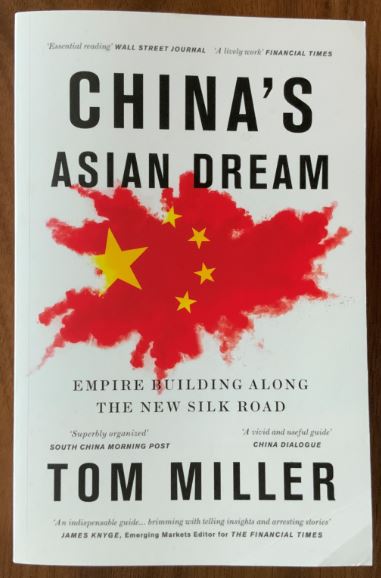Tom Miller’s China’s Asian Dream, is a publication that covers the economic rise of China and provides insight into the diplomatic dance Beijing has ensued with the Euro-Asian world. Under the glaring eyes of the West, -and much to their horror- China has shimmied their economic and commercial benefits they can offer to small developing countries and question arises if these minnows can shimmy away their political and economic sovereignty in a deal that is too good to be true. In six chapters, the author supplements the current geopolitical relationship Beijing has with its neighboring countries with an overview of the history of China, the author begins to describe China’s goals of amassing power and influence through Asia by building a new Silk Road, in a move that can prove to be detrimental if caution is not exercised.
The first chapter details the Belt and Road Initiative taken by President Xi Jinping and discusses how Asian Infrastructure Investment Bank, along with the infrastructural development projects China has undertaken in Asia works towards making the Belt and Road initiative a reality. The following chapter showcases the evident tensions in Central Asia and Xinjiang, their unfortunate position to need China for economic support and their determination to not lose their political sovereignty. This chapter also considers the implications of Russia and how Russia and China are competing for influence in this region. In the third and fourth chapters, we dive into the relations China has with the nations along the Mekong River, namely Laos, Cambodia and Myanmar and how China has boosted the economy of this region however at the cost of negative environmental impacts and human rights issues. The last two chapters discuss the rising conflicts surrounding the South China Sea and the Indian Ocean, and the implications that other interested parties such as the US present to China’s Asian Dream as a whole.
Perhaps the true intention of the author can be captured from the beginning of this book, a colorful thought experiment into 2050, which shows a dystopian future where it paints a horrifying picture with China at the helm and the other nations are run over, burnt to the ground or are just simply powerless. The author argues that the ‘Asian Dream’ of controlling an Asian empire is a dream too far, putting forth that under the façade of Beijing’s ‘win-win’ diplomacy lies an imperialistic ideal to economically leverage nations to rejuvenate the empire they once lost, which can only translate to chaos, as illustrated by the author’s thought experiment. The author also makes a strong case for how China will find it a hindrance to harmonize relations along the borders as each nation is looking out to benefit from China’s largesse without flying too close to the Chinese Sun- get scorched and be subjected to potential loss of political sovereignty. The author also points out that China has a complete disregard for humanitarian issues, while the Western Institutions turn away from funding regimes that are corrupt or have cases of human rights issues, these regimes then turn to China as they have not shown a cold shoulder in the past.
After reading this publication and considering the current affairs in the first quarter of 2021, the halt in BRI seems to be the least of China’s problems. The world has criticized China’s debt-trap diplomacy but in the wake of the COVID-19 pandemic, the distaste towards Chian is even more pronounced. The pandemic will bring a rouse of political and economic implications, mostly felt by China’s growing sphere of influence, nations under the umbrella of the BRI. As these countries frantically attempt to recover from the disastrous effects of the pandemic, they will struggle to service their debts to Beijing—which will expect more favors, and the ceding of more sovereignty, as the cost of debt relief. The nations in Central Asia are weaker economically and have less leverage to stand against the economic might of China. The success of this initiative is unpredictable as the countries in this region are unstable and with the great investment that comes from China, also comes the environmental impacts that these nations have no feasible way of managing. The xenophobia that accompanies with these projects towards the imported Chinese laborers are of note as well, the funds injected by China can be dismissed by these nations as China working towards the control of an Asian Empire. With the current economic and political climate, even though the whole world has experienced an economic downturn, it seems China has not lost hope towards the “Asian Dream”, with ambitious targets toward moderate economic growth and marching towards more coal investment. While the author believes that the US and the other forces will have to accept and accommodate that China will carve out their own empire and the rise of China is seen as an ‘Asian Nightmare’.
In conclusion, the author presents the arguments strategically, guiding the reader towards the events and the perceptions made. These historical snapshots are balanced with perceptive commentary and allows the reader to draw out his/her own conclusions. However, it is of note that there is an inherent bias that is embedded within the lines. China, being the emerging global superpower, with their arsenal of easy funding and technological prowess, it is logical that they would strive to rejuvenate their country. However, the forecast of the dystopian picture of Chinese authoritarian dominance with raining misery is not one I share. With the diplomatic strategy China has employed, it is safe to assume that small nations will prosper and will be empowered. While this is an idealistic perspective, the contrary is to challenge China, but who will challenge China and win? Only time will tell.


